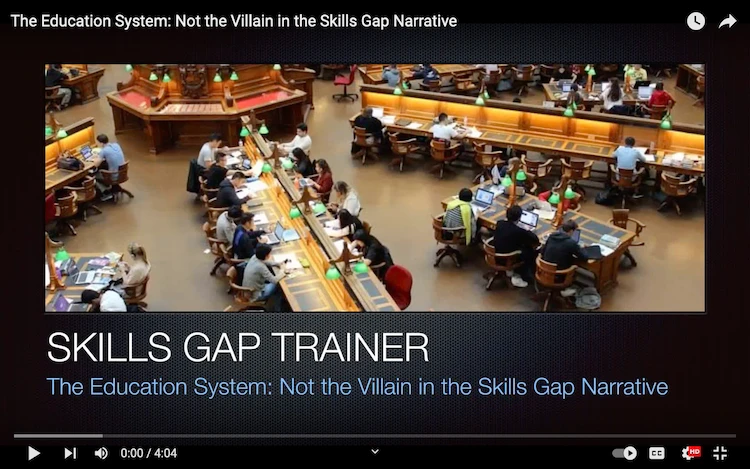Many have come to believe that the so-called “skills gap” is largely a consequence of a failing post-secondary educational system. The origins of this belief are diverse and multifaceted, but one prominent theory suggests that private businesses have played a significant role in perpetuating this narrative. But is it fair to lay the blame at the feet of post-secondary and training institutions?
To assess the validity of this claim, we must first understand the role that educational institutions play in preparing students for the workforce. Students typically select programs that align with their career aspirations. The structure of these programs is often rich with applied components designed to translate directly into the professional realm.
Furthermore, post-secondary institutions have been around for centuries and have evolved into highly efficient and professional entities. They often customize their courses to cater to the specific needs of employers and maintain high academic standards. Thus, it seems reductive to place the burden of the skills gap solely on their shoulders.
However, one cannot deny the value of real-world experience, something that academic institutions struggle to provide in a traditional classroom setting. Employers often cite a lack of experience, not academic skills, as a roadblock in hiring fresh graduates.
This situation begs the question: Shouldn’t employers express frustration with their peers for not offering entry-level experience placements, co-op programs, or internships instead of directing their dissatisfaction towards educational institutions? Is it reasonable to expect academic institutions to single-handedly provide the practical experience that students need?
The answer to this conundrum lies in the shared responsibility between educational institutions and employers. Education provides the foundational skills and knowledge, but real-world experience, which can only be granted by businesses, is necessary to bridge the gap between theory and practice.
To lay the entire problem at the feet of educational institutions is a disservice to their efforts and a distortion of the issue at hand. Both employers and educational institutions must work together, acknowledging their respective roles in providing the holistic training needed for students to transition smoothly into the workforce.
It is critical to remember that our labour market is dynamic, with the demands of the workforce continuously changing. Educational institutions need to adapt their curriculum to these changes, but employers also have a role to play in providing opportunities for real-world experience. Thus, the solution to the skills gap isn’t to point fingers but to foster cooperation and mutual understanding between all involved parties.
Therefore, the blame game needs to stop. Private businesses, educational institutions, and even government policy-makers need to collaborate and form a cohesive strategy that addresses the multifaceted aspects of the skills gap. Only through a collective effort can we hope to bridge this gap and create a workforce that is ready to face the challenges of the modern world.
So, the next time someone points to the educational system as the root of the skills gap problem, it’s worth remembering that there are two sides to this coin. The real challenge lies not just in how we educate, but also in how we facilitate the transition from the classroom to the career, and that is a task that requires the commitment and involvement of all stakeholders.
Related books and resources:
“Academia and Industry Working Together: A Guide for Mutual Cooperation” by David Bridges – This book provides insights into how academia and industry can collaborate effectively.
“Bridging the Skills Gap: Innovations in Education and Training” by Ann Marie Sastry – This resource explores innovative strategies to address the skills gap in the modern workforce.
“The New Education: How to Revolutionize the University to Prepare Students for a World In Flux” by Cathy N. Davidson – This book critiques traditional educational models and offers new approaches to align education with today’s job market.
“The End of College: Creating the Future of Learning and the University of Everywhere” by Kevin Carey – Carey investigates the future of higher education and how it can better prepare students for the workforce.
“Intern Nation: How to Earn Nothing and Learn Little in the Brave New Economy” by Ross Perlin – A critical look at internships and their impact on young professionals and educational institutions.
“Learning by Doing: The Real Connection between Innovation, Wages, and Wealth” by James Bessen – This book examines the relationship between technical innovation and workforce skills development.
“College Disrupted: The Great Unbundling of Higher Education” by Ryan Craig – Craig addresses how current trends are changing higher education and what that means for students and employers.
“Creating a Learning Society: A New Approach to Growth, Development, and Social Progress” by Joseph E. Stiglitz and Bruce C. Greenwald – This resource delves into how lifelong learning and education contribute to societal and economic growth.
“Skill Up: A Software Developer’s Guide to Life and Career” by Jordan Hudgens – Although focused on software developers, this book offers general advice on advancing skills and navigating the modern job market.
To see our Donate Page, click https://skillsgaptrainer.com/donate
To see our Instagram Channel, click https://www.instagram.com/skillsgaptrainer/
To see some of our Udemy Courses, click SGT Udemy Page
To see our YouTube Channel, click https://www.youtube.com/@skillsgaptrainer